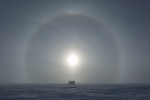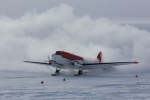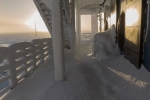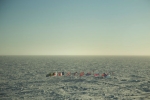Come summer, station personnel eagerly await the first provisions of “freshies,” as they’re called at the Pole. Despite continuing delays last week, a couple more planes have come and gone, leaving a few new faces along with the fresh fruit and bringing the station population to over 50.
This nice sun halo (properly called a 22º halo) that appeared directly above the IceCube Lab meant that there were ice crystals in the atmosphere, one of the reasons that the skiway wasn’t seeing enough action last week. Some folks were all packed up and ready to leave, but no plane was there to take them away as the flight schedule kept being pushed back due to weather. Such is life at the South Pole.
Last week at the Pole, the first two planes of the season arrived (and then departed again—both had short stays). They were small planes, but still, any plane landing at the Pole these days is an exciting event after the long, dark, quiet winter.
Although the South Pole is essentially a desert, a hefty accumulation of snow occurs on and around the buildings there each winter. How is that? Well, it’s the wind. Antarctica is a windy place—even with so little precipitation, it features some extraordinary blizzards thanks to strong winds.
A recent work by Markus Ahlers, a John Bahcall fellow at WIPAC, has shown that fluctuations in the cosmic-ray dipole anisotropy can be understood once the local magnetic field and the presence of local CR sources are taken into account.
With the sun out, you can see again—and here we see all the flags surrounding the marker at the ceremonial pole. They didn’t just appear out of the darkness, though. They were recently replaced for the summer season after being taken down for the winter.






